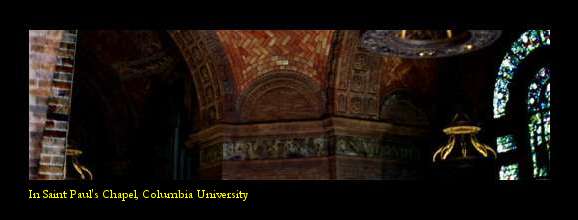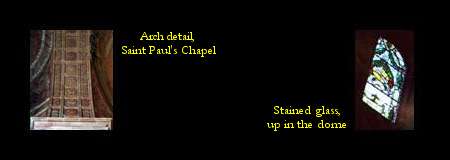|
THE SOUND OF SPACES

An investigation by composer and installation artist
JEFF TALMAN

Enter a large imposing space. Chances are great in a museum lobby that
you will not much notice the sounds in the space, let alone the space itself.
You are absorbed with checking coats, finding friends, buying tickets, getting
a map and other pre-intricacies of viewing museum objects. In a cathedral
or basilica the performance of religious rituals is the sensual focus apart
from the astounding architecture, lighting, windows, artwork - if the sound
impresses you it is the music or the voice of the orator. An airport, a
skyscraper lobby, a botanical garden, an aviary, your bedroom: the goal-orientation
of the space creates near fool-proof distraction to the inherent sound of
the space.
These inherent sounds issue from the winds of interiors, the minute currents
present in any room, which stream across surfaces to create nearly imperceptible
sounds unique to the space. Though little signified these wind sounds permeate
our lives. Perhaps poetic, even profound, these room tones otherwise more
mundanely function everyday in music recording and playback. Audio specialists
know this phenomenon as 'room tone'. Room tone in recording is the medium,
the tabla rasa on which everything exists. To eliminate it is to produce
the high contrast of sonic material and absolute nothingness which early
compact disc recordings sometimes featured to scathing review.

This barely noticeable sound cannot be removed without our aural frames
of reference, our sonic moorings, becoming dislodged. Though secondary to
our visual orientation, we also navigate by hearing. Because it is a secondary
means of orientation hearing is less examined and more intuitively recognized.
We focus on our sight, on objects and motions to make our way. Hearing becomes
a necessary function in orientation mostly for specialized situations: an
ambulance siren, a harbor buoy bell, someone rushing up behind us, a gunshot.
Because of this secondary nature of sound, we generally mask it out to
better focus on the rest of our daily lives. If you listen to the background
sounds in a concert hall as John Cage forces you to do in the highly conceptual
work 4:33, you begin to recognize the continuity of sound all around
us. Cage has us focus on the chance occurrences of immediately discernible
sonic events: coughing, music program rustling, feet scraping and sounds
that bleed in from the outside such as traffic and airplane noises. If you
listen closer in this context you may be able to hear the actual room tone.
A few years ago I was hired, mostly for my ears, to supervise a project
mastering over one hundred music CDs in less than six months. As a musician
I had never really thought very much about room tone. I knew it existed,
but had never worked with it knowingly in any way. With this project I found
myself continually manipulating room tone. I began to think of it as the
'negative space' of the desired sonic images.
Continue >>
Copyright © Jeff Talman, November
20th 1999

| Jeff Talman is a composer and sound installation artist. His works range
from large-space architectural sound installations to orchestral, chamber
and computer-rendered music. The New York Times described Jeff Talman's
work as 'exquisitely muted' and 'luminously still'. He has held teaching
and orchestral conducting positions at Columbia University, the City College
of New York, Heidelberg College and others. He has had numerous composer's
residencies at Yaddo, the MacDowell Colony and the Virginia Center for the
Arts. His new soundspace installation, Vanishing Point 1.1, opened in Saint
Paul's Chapel at Columbia University in New York City, USA on September
22, 1999. For more information regarding the installation visit the Vanishing Point website. |
<< Music &
Vision homepage Peter Grimes in Budapest >>
|